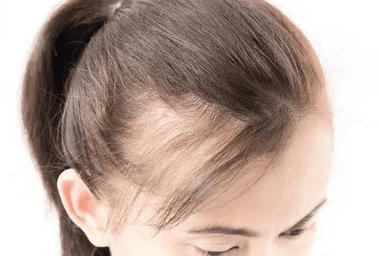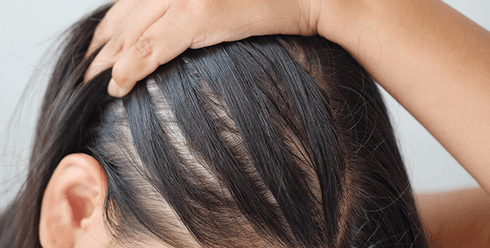Hair loss is a common problem for many women. It can be stressful and impact self-confidence. Understanding the causes of women’s hair loss is the first step to finding a solution.
Causes of Women’s Hair Loss: Understanding the Problem

Hair is often a symbol of beauty and confidence. For women, losing hair can be a distressing experience. While it is normal to shed some hair daily, excessive hair loss can be alarming. Understanding the causes of women’s hair loss is the first step toward finding solutions.
What is Hair Loss in Women?

Hair loss in women, also known as alopecia, can occur for many reasons. It affects women of all ages. It can range from mild thinning to complete baldness in severe cases. Let’s explore the most common causes of women’s hair loss.
1. Hormonal Changes: A Leading Cause of Women’s Hair Loss
Hormonal imbalances are one of the main causes of women’s hair loss. Pregnancy, childbirth, and menopause can trigger these changes. During pregnancy, many women notice thicker hair due to increased hormones. After delivery, hormonal levels drop, causing noticeable shedding. This is called postpartum hair loss.Menopause can also lead to thinning hair. The reduction in estrogen levels weakens hair follicles, leading to hair fall. Hormonal conditions like polycystic ovary syndrome (PCOS) can also cause hair loss. Women with PCOS often experience male-pattern baldness due to excess androgens.
2. Stress and Emotional Trauma
Stress can significantly impact hair health. Emotional stress or sudden trauma can trigger a condition called telogen effluvium. This condition causes hair to enter the resting phase prematurely. Within a few months, hair starts falling out in large amounts. Stress-related hair loss is usually temporary but can be frustrating.
3. Nutritional Deficiencies and Poor Diet
A lack of essential nutrients can weaken hair. Deficiencies in iron, zinc, and vitamins like B12 and D can be causes of women’s hair loss. Women on restrictive diets or with eating disorders are more prone to hair thinning. Protein is vital for hair growth, so a low-protein diet can also lead to hair fall.
4. Medical Conditions and Treatments
Certain medical conditions are direct causes of women’s hair loss. Thyroid disorders, such as hypothyroidism or hyperthyroidism, can affect hair health. Autoimmune diseases like alopecia areata cause the immune system to attack hair follicles. This leads to sudden hair loss in patches.
Treatments for diseases like cancer can also result in hair loss. Chemotherapy and radiation target rapidly growing cells, including hair follicles. While this type of hair loss is often temporary, it can be emotionally challenging.
5. Genetic Factors and Family History
Family history plays a significant role in hair loss. Androgenetic alopecia, or female-pattern baldness, is a genetic condition. It causes gradual thinning of hair, especially on the crown of the head. Women with a family history of this condition are more likely to experience hair loss.
6. Hairstyles and Hair Treatments
Excessive styling can damage hair. Tight hairstyles like ponytails, braids, and buns can cause traction alopecia. This condition damages hair follicles and leads to hair loss over time. Frequent use of heat tools and chemical treatments weakens hair strands. Over time, this can lead to breakage and thinning.
7. Aging and Hair Loss
Aging naturally affects hair growth. As women age, hair becomes finer and less dense. The rate of hair growth also slows down. This is a common cause of women’s hair loss, especially after the age of 50.
8. Scalp Conditions
Scalp health is vital for healthy hair growth. Conditions like dandruff, psoriasis, and fungal infections can cause women’s hair loss. An unhealthy scalp creates an unsuitable environment for hair follicles, leading to hair fall.
Can Hair Loss in Women Be Prevented?
Preventing hair loss depends on its cause. Eating a balanced diet rich in nutrients can promote healthy hair. Managing stress through relaxation techniques like yoga or meditation can reduce stress-induced hair loss. Avoiding tight hairstyles and harsh treatments protects hair from damage.
Seeking medical advice early is crucial. If hair loss is due to a medical condition, timely treatment can minimize its impact. Regular check-ups can help detect hormonal imbalances or deficiencies that may lead to hair loss.
Treatment Options for Hair Loss in Women
Effective treatments depend on identifying the causes of women’s hair loss. Common options include:
- Medications: Minoxidil and other topical solutions can stimulate hair growth.
- Dietary Supplements: Iron, zinc, and biotin supplements can address nutritional deficiencies.
- Hormone Therapy: For hormonal imbalances, doctors may prescribe hormone-regulating medications.
- Hair Transplants: This surgical procedure restores lost hair in cases of severe hair loss.
- Scalp Treatments: Regular scalp massages and medicated shampoos can improve scalp health.
When to See a Doctor
Consult a doctor if hair loss is sudden, severe, or persistent. A healthcare professional can identify the underlying causes of women’s hair loss. Early diagnosis increases the chances of successful treatment.
Final Thoughts on the Causes of Women’s Hair Loss
Hair loss in women is a common but often misunderstood problem. Hormonal changes, stress, poor nutrition, and medical conditions are major causes of women’s hair loss. Genetics, aging, and scalp health also play crucial roles. Identifying the cause is key to finding the right treatment.
By taking care of your overall health, you can protect your hair. If hair loss continues, seek professional advice. With proper care and treatment, it’s possible to restore confidence and improve hair health.
However, You can also read about how to get fair and glowing skin. You can buy products related to beauty and skin care from the Amazon.
Your articles are extremely helpful to me. Please provide more information!
Nice product
Karotin kyukat
excellent
very nice content
Thanks for your write-up.
Thanks for this excellent article. One more thing to mention is that almost all digital cameras come equipped with a zoom lens so that more or less of the scene for being included by ‘zooming’ in and out. These kind of changes in focus length are usually reflected from the viewfinder and on massive display screen right on the back of your camera.
The articles you write help me a lot and I like the topic
Hey would you mind letting me know which hosting company you’re working with? I’ve loaded your blog in 3 completely different browsers and I must say this blog loads a lot faster then most. Can you recommend a good web hosting provider at a honest price? Thanks, I appreciate it!
You can buy hosting plan for hostinger which is the best. You can buy from the below link an get 20% discount by using this referral link.
https://hostinger.in?REFERRALCODE=YSSPOOJAS7E1
https://hostinger.in?REFERRALCODE=YSSPOOJAS7E1
nice content
Well I truly liked studying it. This post offered by you is very effective for accurate planning.
Thanks a lot.
Great blog post.
great topic
excellent
nice content